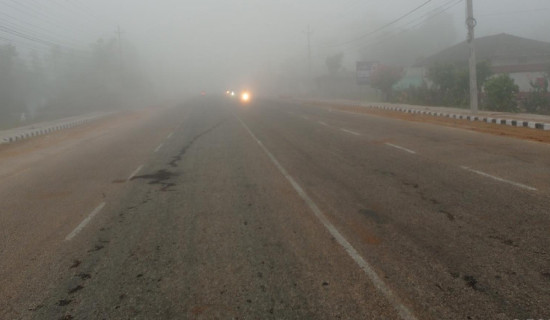- Sunday, 21 December 2025
Fresh Concerns Over Nepal's Official Map
China's recent release of its new standard map has caused astonishment and concerns in Nepal due to its failure to incorporate the Nepali territories identified in its official map that was endorsed by Nepal's Parliament in 2020. China's failure to show Kalapani, Lipulek, and Limpiyadhura as Nepali territories has led to an outcry in the country.
On August 28, China's Ministry of Natural Resources released the country's standard map which did not include the official map of Nepal that prompted Nepal's Foreign Ministry to issue a statement, reiterating the country's adherence to the political and administrative map ratified by the Nepali parliament in 2020 and emphasising the country's determination to settle border issues through dialogue and diplomacy. For many, China's omission of the Nepali territories in the official map goes against the common Nepali belief that China is the closest neighbour of Nepal which respects Nepali sensitivity.
Cartographic issue
It can be recalled that Nepal had in 2020 adopted its official map by including Kalapani, Lipulek, and Limpiyadhura areas that made a 'pointed spur' on the northwestern corner of its map, earning the official map popular Nepali term- Chuche Naksa or the 'pointed map' after India published its official map in 2019 including the aforementioned Nepali territories in its map. The latest Chinese step has exacerbated Nepal's cartographic issue with India which has been claiming these areas its own. By omitting Nepali areas from its standard map, observers argue that China has weakened Nepal's claim to its land on which India has built a 'strategic road' running up to the Chinese border. The route, according to India, is intended to facilitate Indian pilgrims going to the famed Hindu shrine of Kailash Mansarovar, located in China's Tibet Autonomous Region.
With its justified grounds for its claim to the Nepali territories of Kalapani, Lipulek, and Limpiyadhura, Nepal has frequently been raising the issue of a 'pointed map' with India. However, the removal of the pointed map from China's new standard map has surprised many Nepalis, who see the Chinese step as a way of bolstering India's claim to Nepali territories. This exemplifies China's disregard to Nepal's claim for the disputed regions, which India has claimed to be its strategic places. Despite Nepal offering all historical evidence that the territory belonged to her, India has yet to respond to Nepal's plea.
Following the map incident, some renowned Nepali figures have rightfully expressed outrage at the Chinese snub. Demonstrating strong patriotic fervour against the Chinese move, Kathmandu Mayor Balen Shah cancelled his planned visit to China, which was to begin a few days after the publishing of China's standard map. The map release has made it difficult for Nepali authorities to negotiate and convince China to alter its position on Nepal's official map, while the incident has put many Maoist leaders in a spot of bother. Some key Maoist leaders who are perceived to have stronger individual ties with China are optimistic that the issue of Nepal's official map will be raised during PM Prachanda's visit and that efforts will be made by both sides to resolve the matter.
China has remained the closest friendly neighbour and development partner, consistently offering its assistance to Nepal during both good and hard times. It has been a critical trade and business partner of Nepal, with various projects being built and developed in Nepal under China's flagship Belt and Road Initiative (BRI) agreement, which Nepal signed in 2017. Aside from providing considerable assistance to Nepal, the northern neighbour recently opened the Tatopani border which had remained closed for about eight years, to boost smooth trade activities with Nepal. One of the major trade points, the resumption of export and import to and from Tatopani will ease trade activities in Nepal, which is heavily reliant on Chinese goods for its domestic consumption.
Many people in Nepal, particularly those loyal to communist political parties, feel Nepal has a very special relationship with China, which can always play a key role in assisting Nepal in times of crisis. They believe that the Chinese snub on Nepal's official map will be resolved during the Prime Minister's visit to China later this month. In the past, China has resolved several bilateral border issues with Nepal and has consistently allowed Nepali nationals living near the Nepal-China border areas to enter TAR to engage in trade and other activities critical to their livelihood.
Meaningful dialogue
Nevertheless, some China watchers say that the Chinese authorities make their diplomatic moves with ample pre-thought. The publication of the standard map might not have come as a result of lack of attention. As a result, the resolution of this issue may take some time. Observers say the Chinese government does not want to jeopardise its current relationship with India as any disruption in relations with India may undermine its significant trade links with India, another emerging economic force in the globe. According to the latest report, overall India-China trade for 2022 has climbed to USD 135.98 billion, surpassing the USD 125 billion barriers a year earlier by 8.4 per cent.
The current situation with China warrants the need for sustained diplomatic initiatives. Our leaders need to make sure to continually engage in meaningful dialogue and diplomatic manoeuvrings to show the Chinese side that Nepal's concerns regarding its official map are sincere. This will go a long way to resolving any issues between the two immediate neighbours.
(The author is former Managing Editor of this daily.)











-(1)-original-thumb.jpg)




